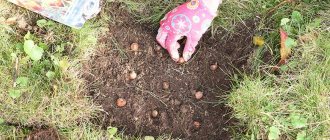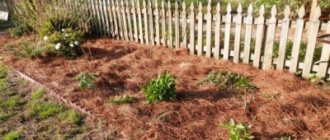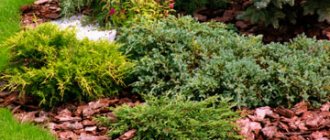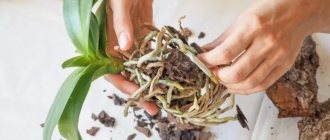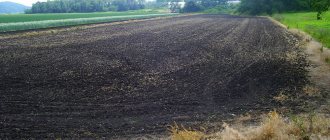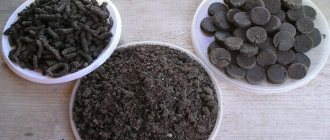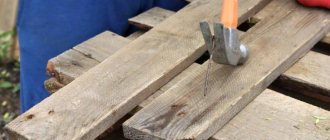Apply fall fertilizer
If the cold has not yet frozen the ground, apply autumn fertilizers to the trunks of bushes and trees. The mixture should not contain nitrogen, but copper, manganese, potassium, boron and other microelements, which we rarely pamper our plantings with, will do just fine.
Ideally, for each mature pome tree you need to add 30-50 kg of humus, 300 g of superphosphate, 200 g of potassium sulfate. Stone fruit crops need a slightly less nutritious mixture. For one plant, 2 buckets of solution prepared at the rate of 3 tbsp will be enough. superphosphate and 2 tbsp. potassium sulfate per 10 liters of water. You can also buy special nutritional complexes with microelements, the packaging of which is marked “Autumn” and use them according to the instructions.
Fertilizers are embedded in the tree trunk circle along the contour of the crown during the autumn digging of the soil to a depth of 30 cm, and after that the tree is watered abundantly.
- Autumn fertilizers - how to feed the garden, vegetable garden and flower garden at the end of the season
We'll tell you how to enrich the soil so that green pets will continue to delight you next year.
WHAT FLOWERS ARE PLANTED IN NOVEMBER
Winter-hardy annual flowers love November as a planting month. Therefore, part of the work postponed until the spring can be done already in the autumn. In November you can plant:
annual chrysanthemums,
nigella,
blue cornflower,
eschsolzia,
dimorphotheca.
These flowers will take root well and will delight you for the next season.
Whiten and tie up the trees in the garden
Before frost sets in, choose a dry day and whiten the trees. Before doing this, remove moss and lichens from the bark, brush over flaky areas with a stiff brush, and spray the trunks and skeletal branches with a 3% solution of copper sulfate. For whitewashing, choose thick mixtures that will not be washed away by the first autumn rain.
On young, thin trees, tie the branches with twine to prevent them from breaking under the weight of accumulated snow.
If you have mice or hares frolicking on your property in winter, wrap tree trunks with spruce branches, old nylon tights, or fence them off with fine-mesh metal mesh.
- How to whiten trees in the garden in autumn
Step-by-step instructions for whitewashing trees in the garden: everything you need to know to carry out the procedure correctly.
In the flower garden
It would seem what things might be like in the flower garden in November, since it’s almost winter. But they still exist, and November can still safely be considered sowing time.
In the spring, during this busy time for summer residents, we almost always do not have time to plant summer trees on time. And then, having sowed them at the wrong time, we can’t wait for a long time to first sprout and then flower.
But you can sow winter-hardy annual flowers in winter, and the best time for this is November. Before winter we plant flowers such as: blue cornflower, eschscholzia, nigella, dimorphotheca, annual chrysanthemums, phlox, lupins, delphiniums, cosmos.
Some perennial flowers can also be sown in November, such as poppies. In addition to planting summer trees, there is still enough work in the flower garden. So, for example, it is necessary to prune those perennials that bloomed later than the others.
But you can leave the ornamental cabbage and, if the winter is mild enough, it will decorate the empty flower garden for a long time and delight us with its colors.
Or you can dig it up, transplant it into a pot and place it on the windowsill in your apartment, where it will grow for a long time.
Let's walk around the site again and check if all the heat-loving perennial plants are covered.
It is also necessary to take care of vacated flower pots and flowerpots. They need to be washed and dried well.
Limescale deposits on clay containers can be washed off very well with a brush with hot water and soap, as well as with a vinegar solution (1 teaspoon of table vinegar per glass of water).
Moss and mold will help clean clean and dry sand perfectly. Then we carefully place the cleaned flower containers in the utility room until the next summer season.
My dear readers, our summer season has ended. Now we will have time to dream about new plants, carefully plan everything on our plots, learn from the successful experiences of other gardeners, flower growers and gardeners and, of course, analyze our mistakes.
See you again, dear friends!
Carry out moisture-charging watering of the garden
If autumn in your region is dry and there are no prolonged downpours that wet the ground to a depth of more than half a meter, do not forget about moisture-charging irrigation. It should be carried out no later than mid-November and only if there are no frosts in the forecast for the coming days.
For high-quality and deep watering, it is advisable to drill holes up to 100 cm deep along the perimeter of the crown. Pour water gradually, preventing it from spreading like a lake throughout the entire area.
Keep in mind that trees at different ages need different volumes of water for a good winter:
- at 3-5 years – 50-80 l;
- at 7-10 years old – 120-150 l;
- more than 10 l – 150-200 l.
- How to water fruit trees in the fall - the secrets of moisture-charging irrigation
To water or not to water? And if so, how? Let's understand the intricacies of watering the garden in the fall.
Preparing soil for seedlings
Prepare your fertilizers for spring - the choice in stores is limited and is limited only to peat with small additives. Pour into sugar bags or thick plastic bags and label with a marker: river sand, turf soil, humus, sawdust - these components are included in most recommended substrates. You can store the soil on the balcony - freezing will only be beneficial, and thawing in the room will only take a couple of days.
In November, you can plant tulip bulbs if you purchased them late. They can take root only if the weather is mild within a month after planting, with a temperature of at least 5 degrees. At lower and negative temperatures, root growth will stop and the bulbs will freeze. Therefore, it is better to plant tulip bulbs in November - December for forcing at home. 3-4 months after planting, sprouts will appear, which, when they reach 8 cm, are transplanted into pots and placed in a bright place. You can also plant other bulbous plants for forcing in November.
In the fall, you can sow flowers whose bags say “stratify before planting” and this is called winter sowing. Annual flower crops are usually sown in late autumn, when frosts hit.
Before winter, annuals are sown: asters, marigolds, blue cornflower, godetia, Ajax delphinium, dimorphotheca, iberis, calendula, clarkia, collinsia, cosmos, lavatera, lobularia, malcolmia, matthiola, mignonette, scabiosa, Drummond phlox, chrysanthemums, eschscholzia.
For these flowers, winter sowing has an advantage over spring sowing. Shoots appear in early spring, when the ground is still moist and cool, which is very important for seed germination.
There are perennial plants that are also preferable to sow before winter, in November. These are adonis vernacular, aconite monkshood, brunner macrophylla, speedwell, columbine, helenium autumnalis, doronicum, iberis, gypsophila paniculata, bellflower, lupine, milkweed, aubrieta, sedum, rudbeckia, scabiosa, phlox paniculata, evening primrose, echinacea.
Sow the seeds of all crops thicker than in spring and sprinkle with sifted peat. Cover the top of the planting with dry leaves and press these leaves with spruce branches. This will help maintain a constant temperature.
Clean and mulch tree trunk circles
With the onset of cold weather, when frost and hard crust form on the surface of the earth in the morning, clean the tree trunk circles. Remove old mulch, rake up fallen leaves and remove the top layer of soil (up to 5 cm). In its place, pour a layer of fresh lowland peat 10-15 cm thick.
This way you will get rid of not only some of the overwintering pests, but also the spores of fungi, bacteria and pathogens that have infected the soil.
- How to mulch the tree trunk?
In order to mulch the tree trunk correctly, you just need to observe nature: what materials usually cover the roots of the tree. Let's look at the different options.
Work in the garden in November
Pre-winter sowing of beds
It’s not for nothing that the last month of autumn is called the “twilight of the year.” The sun is a rare visitor in November, the low sky is usually overcast with leaden clouds, and daylight, which accounts for just over seven hours, is mostly diffuse. But it is during this period that the last sowing of vegetables is carried out. As soon as the soil freezes to a depth of 2-3 cm (usually this happens in the second ten days of November), you can begin sowing.
Choose varieties that are resistant to low temperatures:
- parsley (Common leaf, Irinka, Vereiskaya, Felicia),
- lettuce (Gauguin, Zador, Cook, Sanzhin, Luck, Emerald Giant, Ruby Frost, Santin);
- head lettuce (large head, Berlin yellow),
- dill (Fragrant bouquet, Gribovsky, Green bunch, Russian giant),
- spinach (Fatty leaf, Gigantic, Puma R, Rembrandt R, Rembord)
- sorrel (Large-leaved, Nikolsky, Malachite, Champion),
- onions for greens (Bessonovsky local, Spassky local improved and Pogarsky local improved, Arzamas local);
- radishes (Heat, Mochowsky, Early Red, Rhodes, Rose Red with White Tip).
Putting things in order in the garden
While the days are nice, put the area in order. Clear the beds of leaves, plant debris and other debris. If drainage ditches and row spaces are heavily overgrown with weeds, pull them out. Pump out the water from the drainage well. The hose can be thrown into a ditch through which water flows outside the garden community or into a fire pond. Mark on the diagrams where and which vegetables were sown and which ones were left to overwinter in the garden. Otherwise, in the heat of spring work, you will accidentally dig them up. Inspect the supply of fertilizers, pesticides, garden soil, sawdust, etc. Disinfect the greenhouses: treat the frames and frame with a 10% solution of caustic soda or a weak solution of bleach. If the weather permits, you can dig up remote virgin areas.
When digging, do not break clods of earth. This will allow you to destroy pests overwintering in the ground, and in the spring it will be easier to arrange a garden bed in this place.
Setting up mini-cellars
If your city apartment and cellar no longer have room for jars of pickles and preserves, you can place them directly in the garden. Dig a trench 10-15 cm higher than the height of the cans. Grease the tin lids, cover with paper or film, place a board on top and cover with earth and later with snow. You can bury an old refrigerator or bathtub flat in the ground - they will also make excellent mini-cellars.
Checking the safety of root crops
In November, try to inspect the bins more often. Especially those places where potatoes are stored. If you find affected tubers, select them and destroy them. The optimal temperature for storing root vegetables is 2-3 degrees. If the storage is colder than normal, cover the tubers with straw, burlap, shavings, and matting. A sign of hypothermia (as well as excess moisture in the air) is the formation of droplets on the ceiling.
Before storing root crops, they should be washed
To protect the potatoes, add 2-3 layers of beets on top. This root vegetable is more resistant to disease and dampness. You can place 1-2 boxes with quicklime, salt, and charcoal in the storage. They will absorb excess moisture, just do not forget to periodically change the filler.
Cover the strawberry beds
To prevent rosettes of garden strawberries from freezing, cover them with spruce branches, cut branches of raspberries or other berry bushes. This will help retain the snow on the ridge and protect the capricious crop from the first autumn and last spring frosts.
- The best way to mulch strawberries: 10 materials for every taste and budget
What material to choose for mulching strawberries so that they grow well, do not get sick and do not require additional care efforts.
Complete harvest of cold-season crops
If you still have late white cabbage, Brussels sprouts, the last greens, viburnum or rowan berries left on your plot, it’s time to remove them. Do not forget to remove plant debris (tops, stems, stumps) from the ridges, since with a high degree of probability they have become food and shelter for insect pests.
- How to keep cabbage fresh until spring
We tell you how to properly store cabbage in the winter in the cellar and apartment so that the heads of cabbage do not spoil until spring.
Sow vegetables before winter
To reduce your spring work and free up the hot May hours, sow some vegetables and herbs in the fall. Autumn sowing is well tolerated by carrots, beets, spinach, parsley, dill, etc. In addition, in late autumn you can plant small onion sets, which otherwise will dry out until spring.
- What can be planted before winter - a list of garden plants with variety names
Don't know what you can plant in your garden before winter? Believe me, almost all vegetables, it’s enough to choose the right varieties and prepare the beds.
What to plant in November at the dacha in a greenhouse
In November, a wide variety of crops can be planted in a greenhouse by installing heating and additional lighting lamps. A simple option is to place onions to get their greens. Onions are extremely unpretentious; they do not need a lot of light or elevated temperatures. This crop actively grows green mass, so it will be appropriate in a greenhouse in November.
| The following types of onions work well in the greenhouse: multi-tiered, batun, chives and slime. |
Naturally, the greenhouse is suitable for growing lettuce and spinach. Arugula, rhubarb, and chard will definitely yield a harvest. They will develop and grow quite normally in a heated greenhouse with additional lighting. If the day is sunny, then they will not need additional lighting.
Early ripening and medium-sized varieties of radishes can be sown in the greenhouse. For such varieties, it only takes a couple of weeks and the harvest can be harvested.
Photo: Planting in a greenhouse in November.
We can also give the green light to radish lovers. Feel free to sow the seeds of this healthy vegetable crop in the greenhouse. If you are a resident of the southern region, then you can even do without additional heating. If cucumbers or other members of this family were grown in a greenhouse in the summer, then you will definitely reap a high harvest of radishes there.
Those who simply cannot imagine life without a variety of herbs can sleep peacefully. You can also sow them in the November greenhouse; crops such as basil, parsley, dill, coriander and even fennel will grow well there and give excellent yields.
Prepare soil mixture for seedlings
Before the onset of cold weather in dry weather, prepare a universal soil mixture for growing seedlings. It is easy to do - you need to mix turf soil, humus and sand in a 1:2:1 ratio. Add 3 tablespoons to each bucket of mixture. wood ash.
Place the soil mixture in bags and store it in a dry place, from where you can remove it as needed. If soil diseases are raging in your area, before adding ash, calcine the soil in the oven or pour it with a fungicide solution (option: a bright pink solution of potassium permanganate), and then dry it.
- Soil for seedlings - how to prepare the right mixture for young plants
Seedlings of tomatoes, peppers, eggplants, cucumbers and cabbage will be strong and healthy if grown in the correct substrate.
Clean and put away garden tools
You should not throw shovels, pitchforks, rakes, and especially garden equipment in the middle of the site. Even if no one encroaches on the equipment in an empty holiday village, such a winter will definitely not do it any good - the handles will dry out, the plastic parts will crack, and the iron will rust.
- How to store garden equipment in winter (infographic)
Minor or major repairs, cleaning, lubricating, sharpening cutting parts - what else needs to be done while garden equipment is idle in winter?
Carefully clean the tool from the ground, drain the fuel from the equipment, wipe all elements with a dry cloth and put it in a dry place until spring.
In late autumn, there are many discounts and sales at garden centers, where you can get good deals on out-of-season items, including seeds and tools.
Cover flowers and conifers overwintering in the ground
After the autumn rains have passed and slight but stable cold weather has set in, cover flowers, conifers and heat-loving shrubs. Remember that the likelihood of damping off in such plants is much greater than freezing, so do not rush with shelter.
For shelter, you can use branches with leaves left after autumn pruning, spruce branches, frame structures, agrofibre, straw, etc. Remember that the shelter will need to be periodically checked and ventilated - its frame should not press the plant to the ground.
- Sheltering plants for the winter - debunking myths
How to protect plants from frost, cold wind and precipitation? Do they always need to be covered for this and why do summer residents do it wrong?
And since a true summer resident knows that the season never ends, we are sure that in winter you will find something to do in your favorite area.
